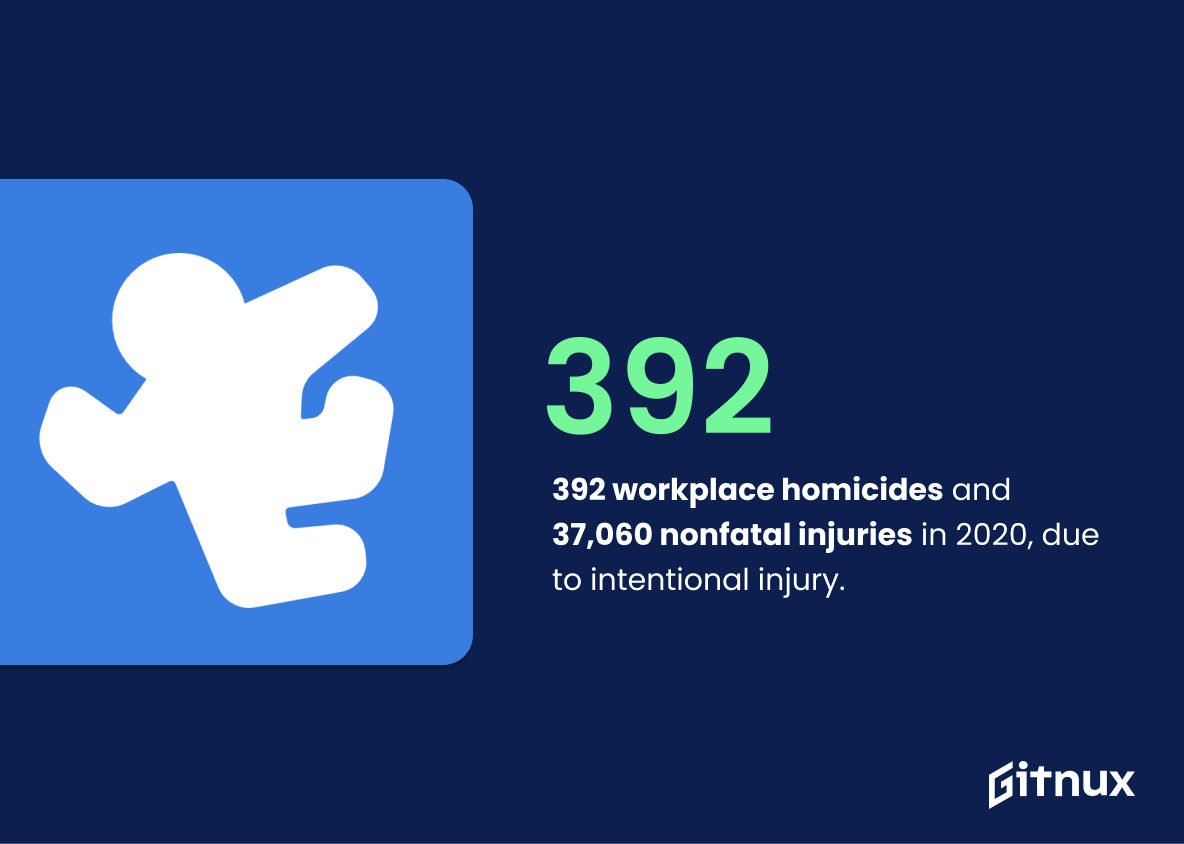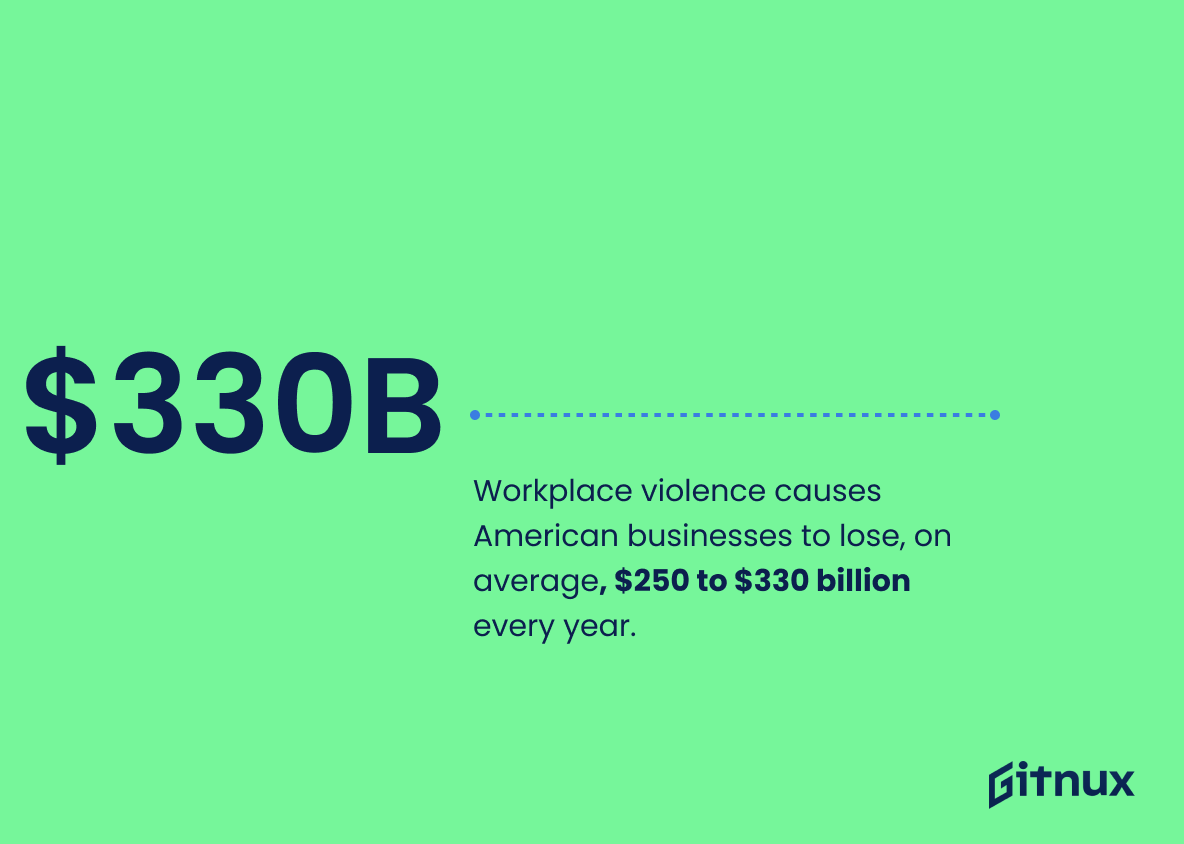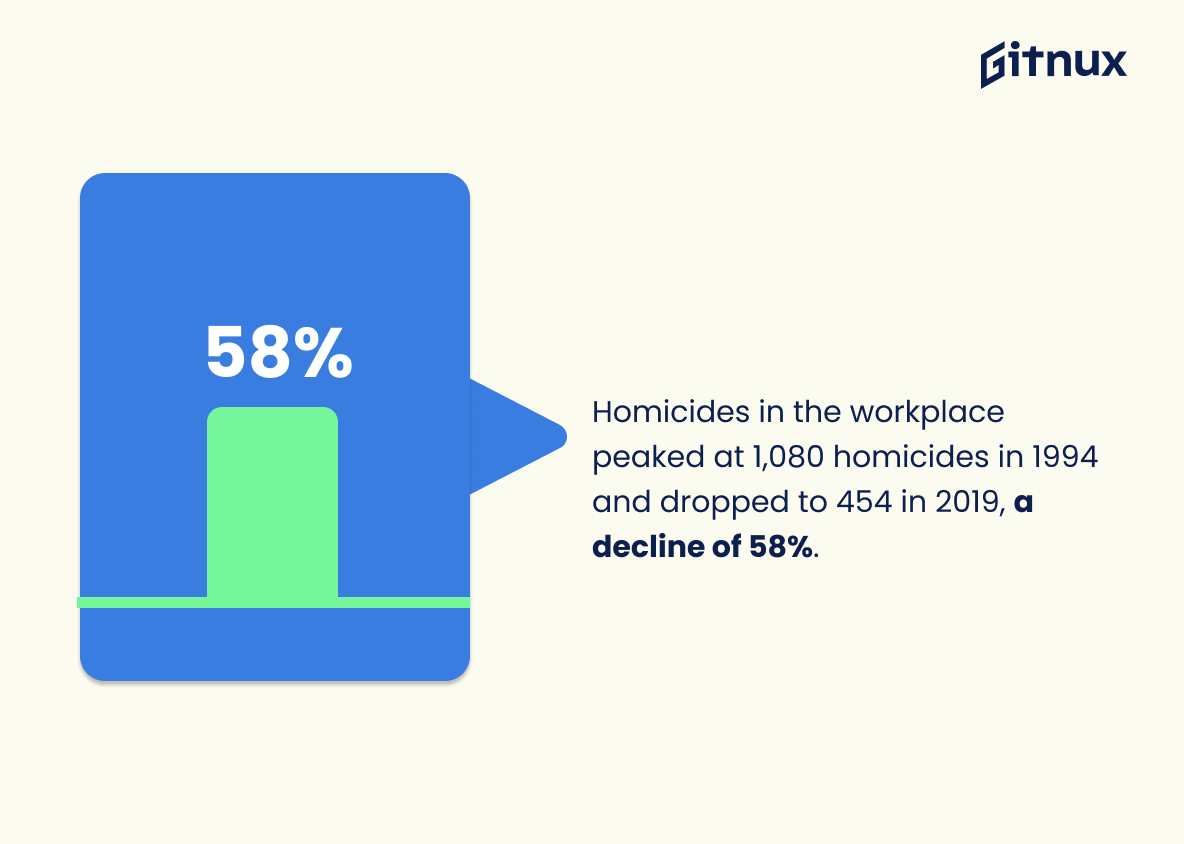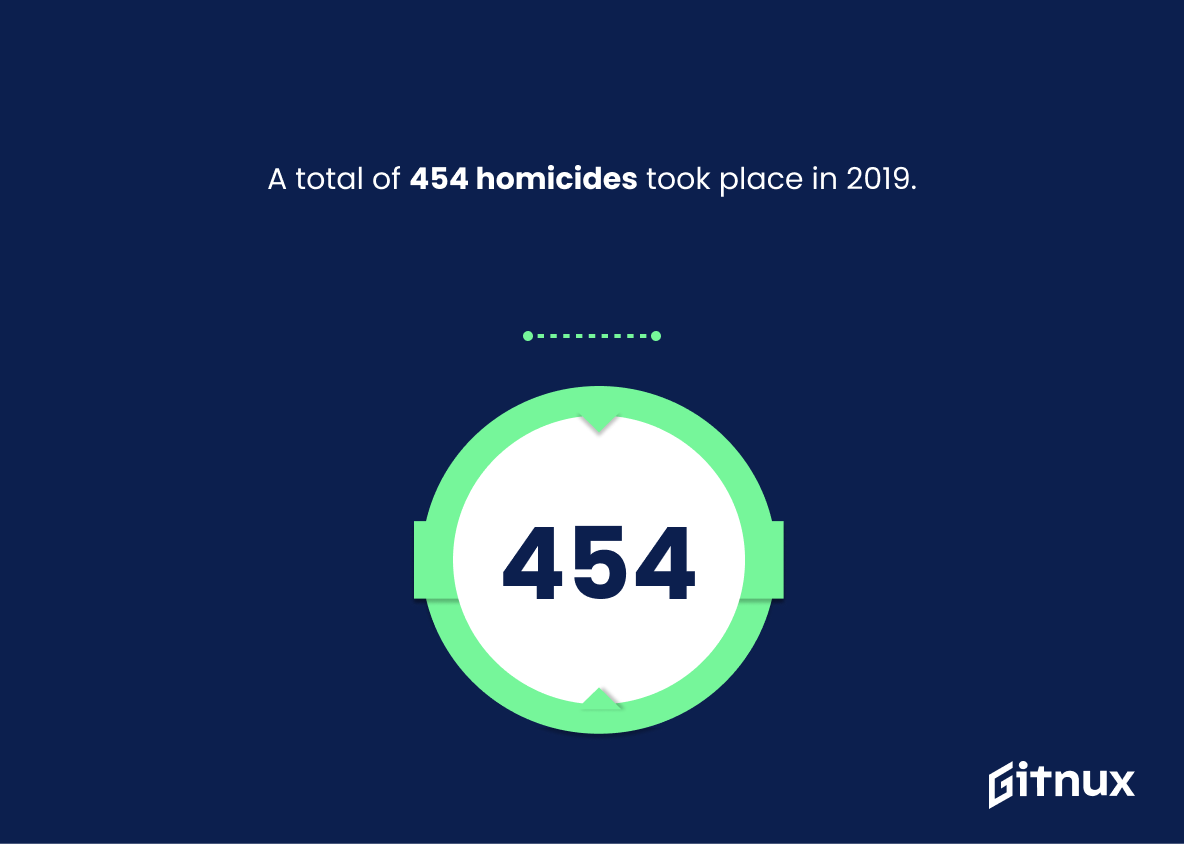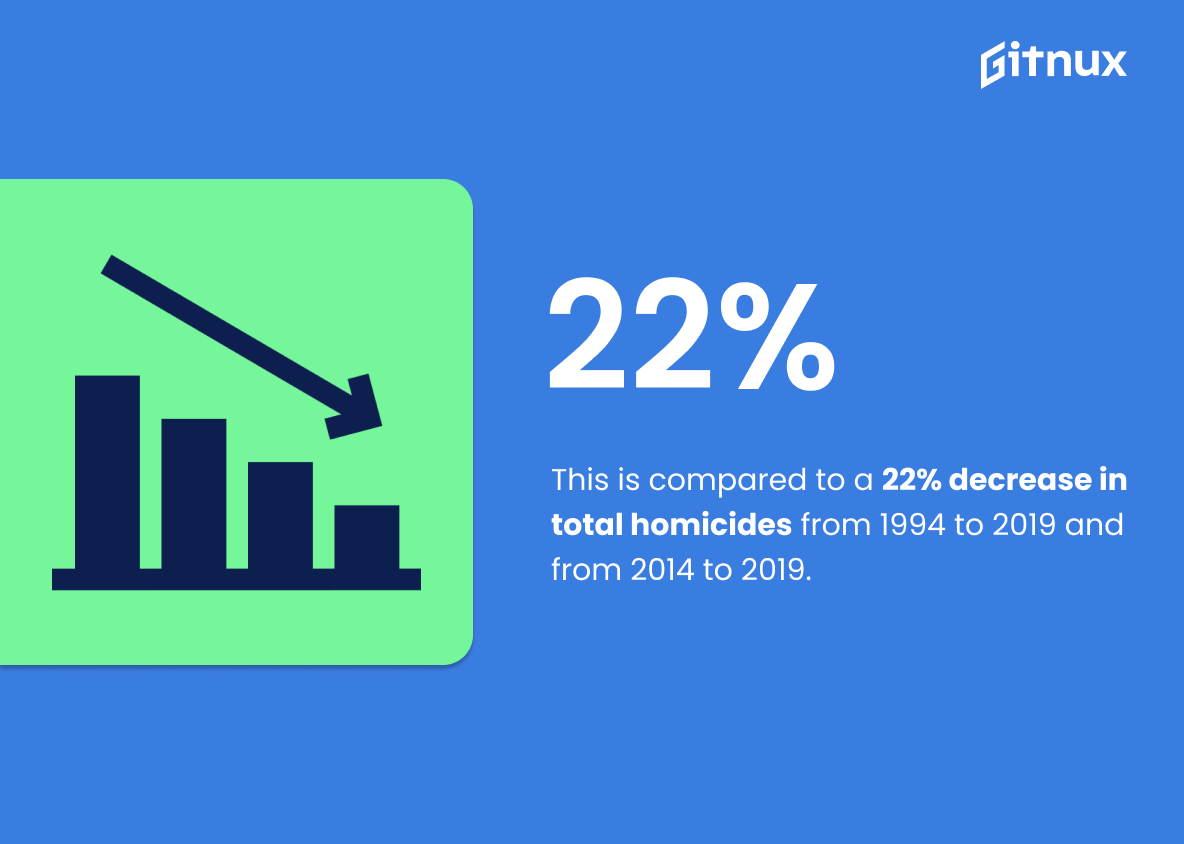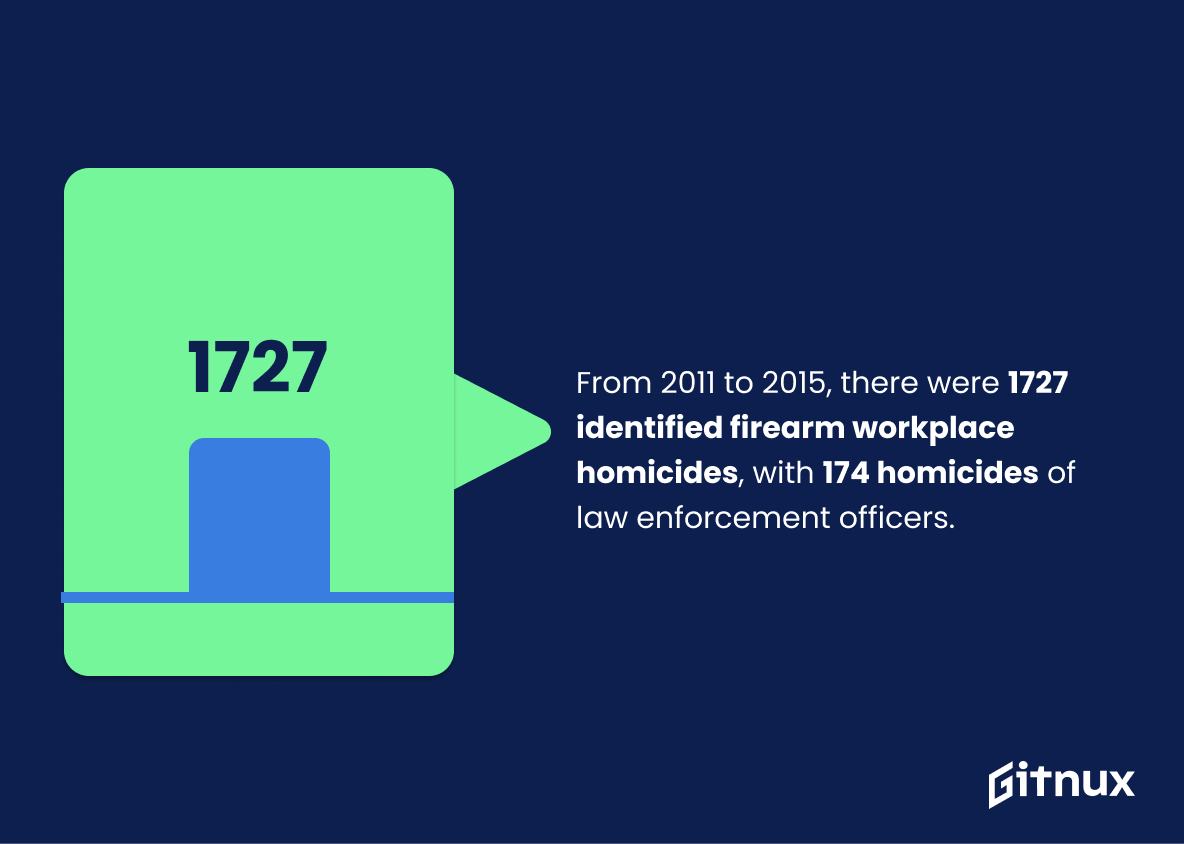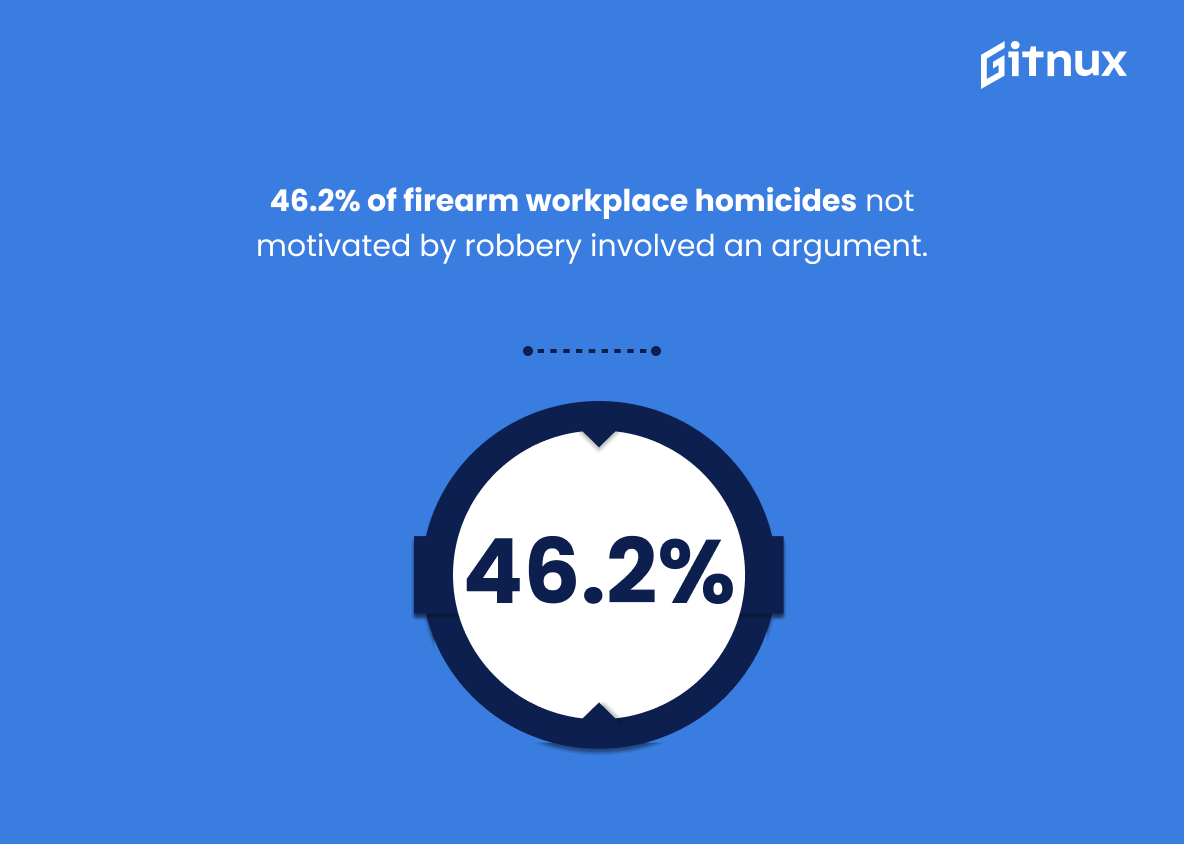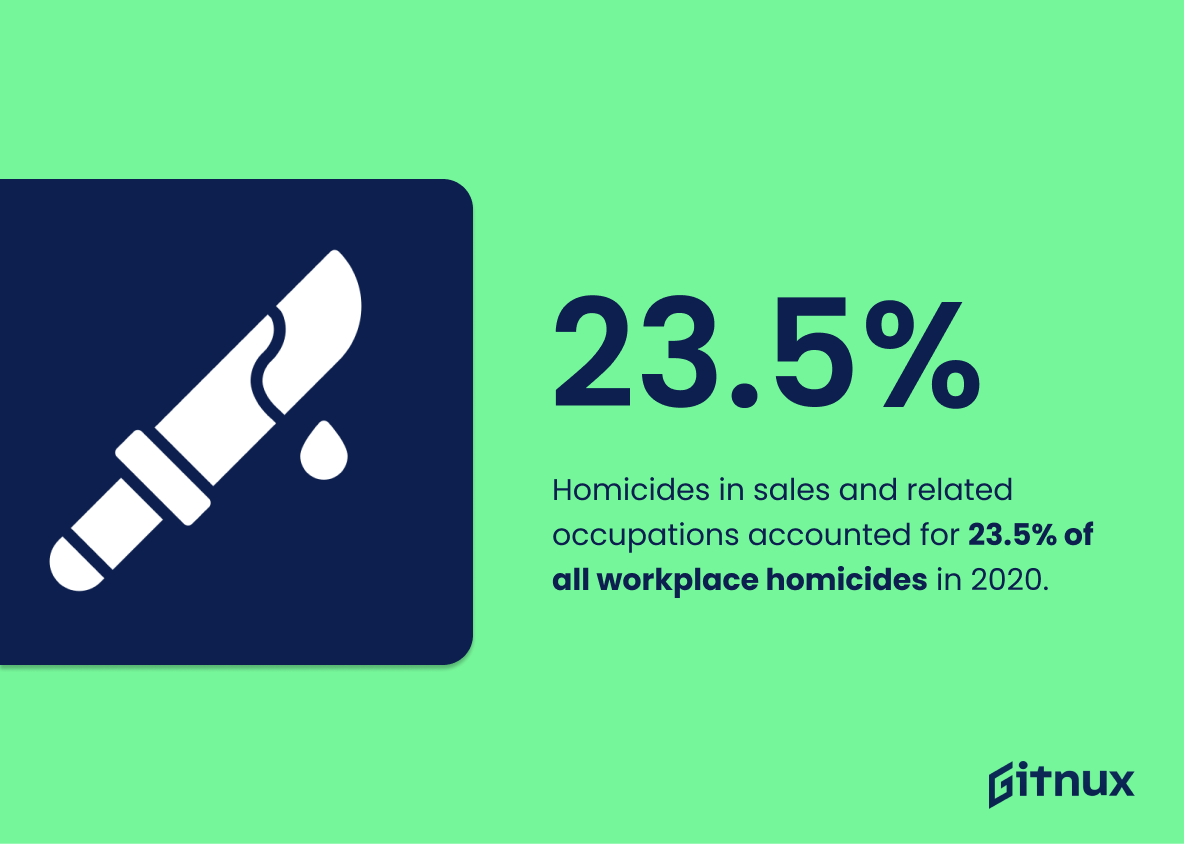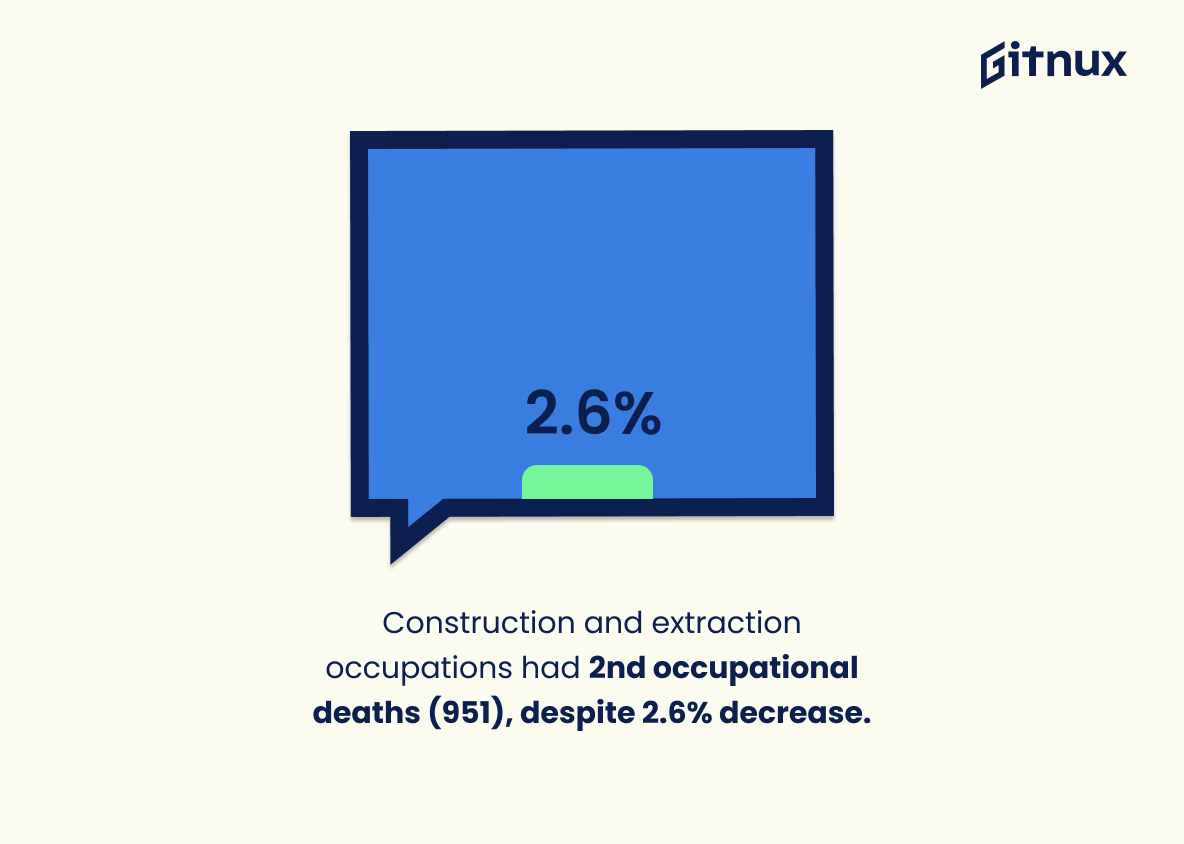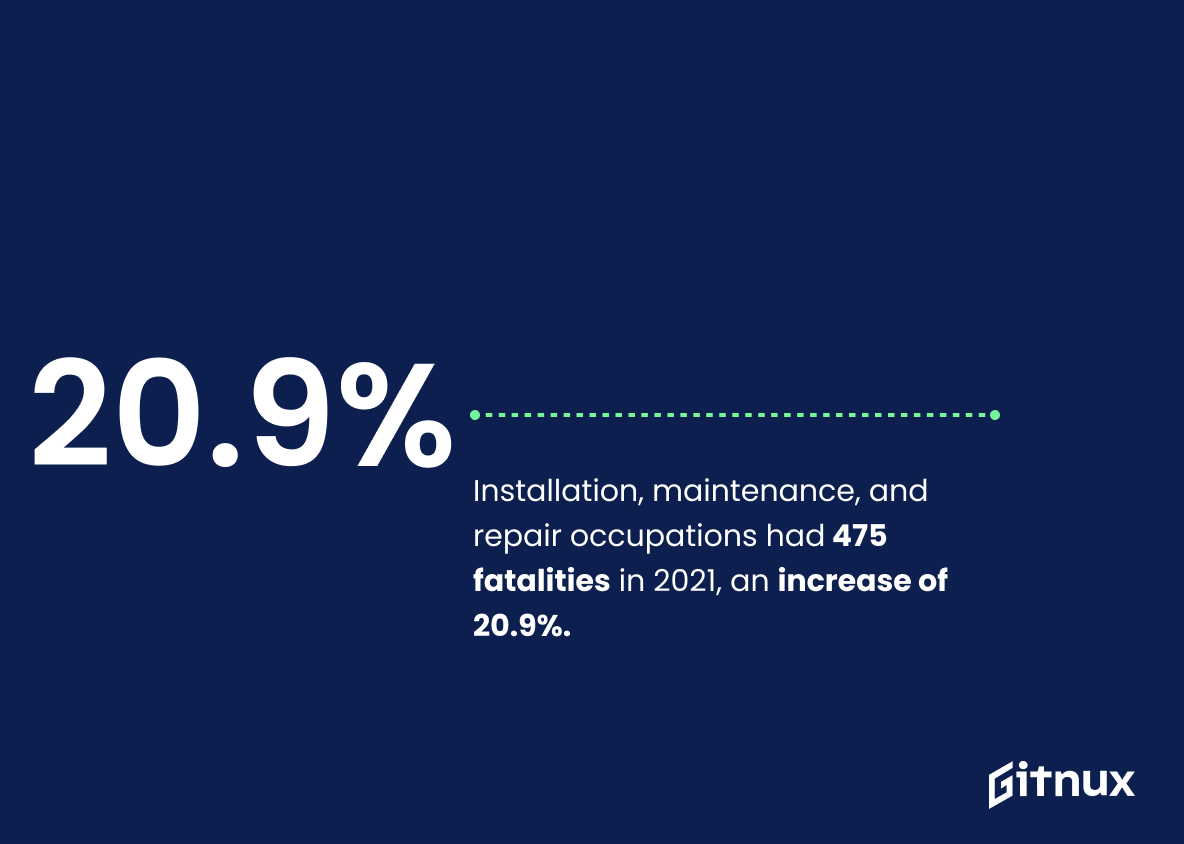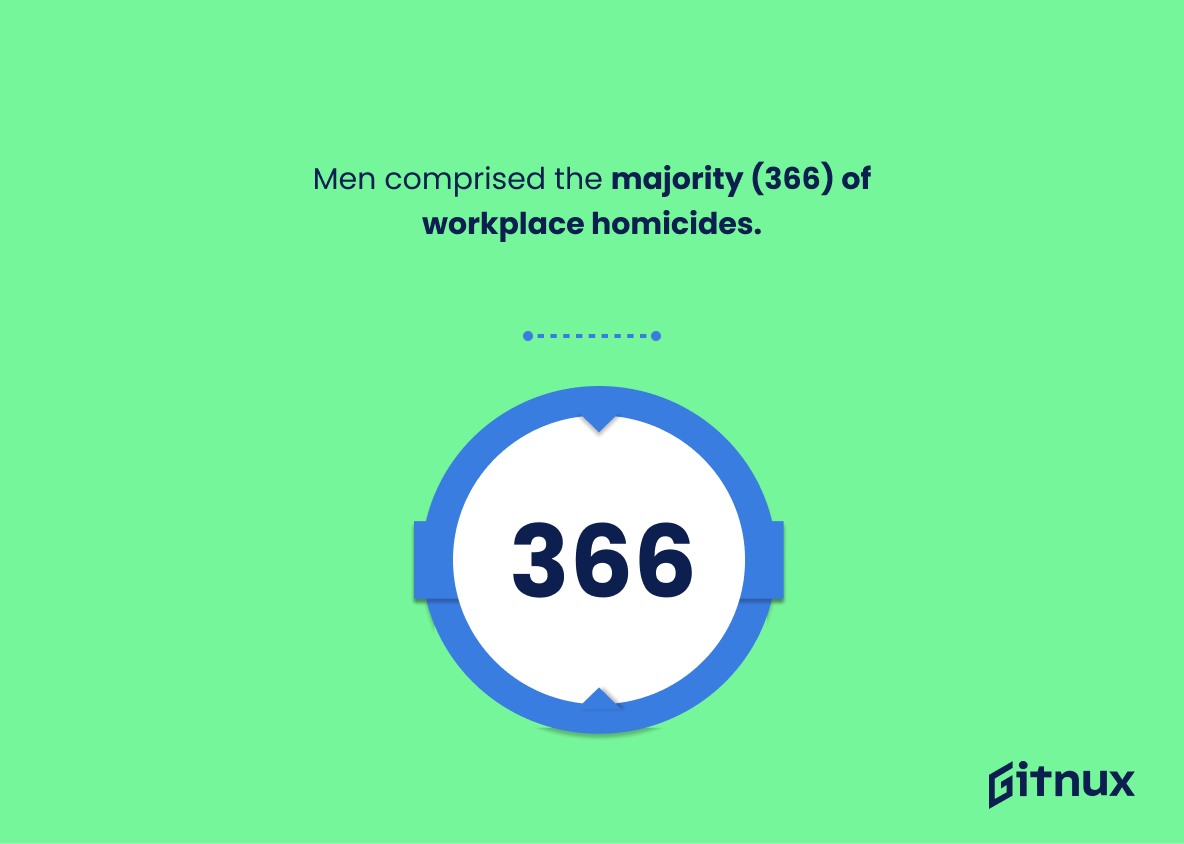Workplace violence continues to be a pressing issue that companies from all sectors grapple with across the United States. Today, millions of people fall victim to workplace violence each and every year.
Firearm workplace homicides are a significant problem in the United States; since customers and co-workers who commit these crimes were often armed at the time of the argument. Some were not and retrieved a firearm from an unspecified location before committing a homicide.
Unfortunately, when it comes to gender bias it seems that more women are killed at their workplace compared to men.
This article shall discuss some criteria that may pinpoint important factors towards workplace homicide, such as gender, occupation, and firearm availability.
Workplace Homicide: The Most Important Statistics
There were 1553 firearm workplace homicides from 2011 to 2015.
Jobs with a high number of cash handling, such as cashiers, motor vehicle operators and gasoline stations are more prone to violence; making robbery 43.10% of the most common assailant of workplace homicide.
Workplace Homicide Statistics
There were 392 workplace homicides in 2020, as well as 37,060 nonfatal injuries in the workplace; resulting from an intentional injury by another person.
The five occupational groups with the most workplace homicides in 2020 were sales and related, transportation and material moving, management, construction and extraction, and production.
In the United States, there are roughly 2 million victims of workplace violence each year.
Workplace violence death rates for men are roughly 75% higher than those for females.
Workplace violence causes American businesses to lose, on average, $250 to $330 billion every year.
Non-robbery crimes constituted almost 50% of the homicides and trended upward in recent years.
Customers and co-workers were the most frequent perpetrators of non-robbery crimes, most after an argument.
Workplace Homicide Statistics Trends
Over a 27-year period from 1992 to 2019, nearly 18,000 persons were killed at work, on duty, or in violence that was work-related.
Homicides in the workplace peaked at 1,080 homicides in 1994 and dropped to 454 in 2019, a decline of 58%.
During a more recent period from 2014 (409 homicides) to 2019, workplace homicides increased by 11%.
A total of 454 homicides took place in 2019.
This marked a 58% decrease from a peak of 1,080 homicides recorded by the CFOI in 1994.
This is compared to a 22% decrease in total homicides from 1994 to 2019 and from 2014 to 2019.
Workplace homicides have fallen more than 50% from a high of 1,080 in 1994.
Are All Workplace Homicide Cases Gun Related?
While customers and co-workers who commit these crimes were often armed at the time of the argument, some were not and retrieved a firearm from an unspecified location before committing a homicide.
There were 1553 firearm workplace homicides from 2011 to 2015.
Each year, approximately 400-500 homicides occur while victims are at work, accounting for about 9% of the approximately 4,800 workplace fatalities that happen in the U.S. every year.
Nearly 80% of those workplace homicides were classified as intentional shootings.
From 2011 to 2015, there were 1727 identified firearm workplace homicides, including 174 homicides of law enforcement officers.
Of the 1553 non-law enforcement firearm workplace homicides, 39.9% took place during robberies, 47.9% were not motivated by robbery, and 12.2% were unknown motivation.
Among the 744 firearm workplace homicides not motivated by robbery, 46.2% involved an argument, 29.6% involved a conflict, and 24.2% were other circumstances.
Which Occupations Are More Prone to Homicide?
The five occupational groups with the most workplace homicides in 2020 were sales and related, transportation and material moving, management, construction and extraction, and production.
Homicides in sales and related occupations accounted for 23.5% of all workplace homicides in 2020.
There was a 16.3% increase in deaths for drivers and sales workers, which went up to 1,032 deaths in 2021 from 887 deaths in 2020.
Construction and extraction occupations had the second most occupational deaths (951) in 2021, despite experiencing a 2.6% decrease in fatalities from 2020.
Protective service occupations had a 31.9% increase in fatalities in 2021, increasing to 302 from 229 in 2020.
Installation, maintenance, and repair occupations had 475 fatalities in 2021, an increase of 20.9%.
Almost one-third of these deaths (152) were to vehicle and mobile equipment mechanics, installers, and repairers.
Jobs with a high number of cash handling position, such as cashiers, motor vehicle operators and gasoline stations are more prone to violence; making robbery 43.10% of the most common assailant of workplace homicide.
Are Women More Likely to Experience Workplace Homicide Than Men?
Men comprised the majority (366) of workplace homicides.
Homicides accounted for nearly three times the share of all workplace deaths for women than for men.
Around 20% of all workplace deaths occurring to women (88 of 437) were due to homicide, compared to 7.5% of all workplace deaths occurring to men (366 of 4,896) in 2019.
The total rate of homicides for women in 2019 is 20.1%.
From 2010 to 2019, 34% of women who died at work died by homicide.
Among men, only 6% of workplace deaths were from homicide.
Women who are killed at work tend to be victims of violence by strangers, usually with criminal intent, such as robbery.
From 2010 to 2019 in Washington State, 22 women and 36 men died at work by homicide.
Supplementary Statistics
Workplace homicides accounted for 10% of all fatal work injuries in 2019.
This is a stark reminder of the prevalence of workplace homicides in 2019, highlighting the need for employers to take proactive steps to ensure the safety of their employees. It serves as a call to action for employers to take the necessary steps to protect their employees from the dangers of workplace violence.
In 2018, there were 453 workplace homicides in the United States.
Workplace homicides are a serious issue that needs to be addressed. It also serves as a call to action for employers and employees to take steps to ensure that their workplaces are safe and secure.
79% of workplace homicides in 2018 were committed using firearms.
It highlights the need for employers to take proactive steps to ensure the safety of their employees, such as implementing gun control policies and providing training on how to respond to active shooter situations.
Women made up 34% of workplace homicide victims in 2017.
Employers, therefore, need to take proactive steps to ensure the safety of their female employees, as well as the need for greater awareness of the risks of workplace homicide.
88% of the workplace homicide victims in 2017 were men.
Men are disproportionately affected by workplace homicide. It highlights the need for greater awareness and prevention of workplace violence, particularly for male employees. It also serves as a call to action for employers to take steps to ensure the safety of their male employees.
In 2018, the retail industry experienced 124 workplace homicides.
This serves as a warning to employees to be aware of their surroundings and to take necessary precautions to protect themselves.
Homicides in workplaces declined 58% between 1994 and 2001.
The efforts to make workplaces safer have been successful, and the trend of decreasing workplace homicides is continuing. This is an encouraging sign for those who are concerned about workplace safety, and it serves as a reminder that continued vigilance is necessary to ensure that workplace homicides remain at a low level.
In 2010, the U.S. taxi driver and chauffeur occupational group had the highest workplace homicide rate, with 7.4 homicides per 100,000 workers.
This is a stark reminder of the dangers that taxi drivers and chauffeurs face in their line of work. It highlights the need for increased safety measures and better protection for these workers, who are at a disproportionately high risk of becoming victims of workplace homicide.
Law enforcement officers experienced a workplace homicide rate of 2.1 per 100,000 full-time workers in 2018.
Despite the best efforts of law enforcement agencies to protect their officers, workplace homicides remain a real and present danger. This statistic serves as a reminder that law enforcement officers are at risk of being victims of workplace homicides and that steps must be taken to ensure their safety.
Homicide is the leading cause of workplace deaths among women, accounting for 39% of their workplace fatalities.
Thus, there is a need for employers to take proactive steps to ensure the safety of their female employees, as well as the need for greater awareness of the risks of workplace homicide.
Between 2011 and 2019, there were an average of 45 workplace homicides per year in California.
It paints a picture of the magnitude of the issue, highlighting the need for greater awareness and prevention measures to be taken.
In the UK, there were six workplace homicides between 2018 and 2019.
This serves as a call to action for the government to take steps to reduce the number of workplace homicides in the UK.
Workplace homicides decreased by 19% from 2015 to 2016.
The efforts to make workplaces safer are having a positive effect, and further steps can be taken to continue to reduce the number of workplace homicides.
Workplace homicides accounted for 9.1% of all job-related fatalities in 2010.
Workplace homicides are a real and present danger, and that employers and employees alike must take steps to ensure their safety. It serves as a reminder that workplace homicides are a serious issue that must be addressed in order to protect workers and ensure their safety.
22% of workplace homicides in 2017 were committed by robbers and other perpetrators.
Thus, there is a need for law enforcement to take a proactive approach to preventing workplace homicides.
Government workers had a workplace homicide rate of 0.5 per 100,000 workers in 2018.
This provides a benchmark for comparison, allowing us to measure the relative safety of government workplaces compared to other industries. It also serves as a reminder that workplace homicides can occur in any industry, and that employers should take steps to ensure the safety of their employees.
Between 2011 and 2015, the workplace homicide rate among black workers was nearly 2 times greater than the rate for white workers.
Black workers are therefore disproportionately affected by workplace homicides, and more needs to be done to ensure their safety. It is a call to action to employers and policymakers to take steps to reduce the risk of workplace homicides for all workers, regardless of race.
Conclusion
Unfortunately, even when it seems an issue such as workplace-related homicide might be a bit far-fetched, it tends to happen way more often than any of us would even consider. This may result in some avoiding certain occupations like driving or cashiers as they have a higher workplace homicide rate, which is nothing but tragic.
As for gender, men seem to have experienced more homicide in the workplace than women. However, this does not mean that women are completely safe, since there has been a substantial amount of female workplace homicide rates.
FAQ
What are the most common motives for workplace homicide?
The most common motives for workplace homicide are revenge, robbery, and disputes between coworkers.
What are the most common methods of workplace homicide?
The most common methods of workplace homicide are firearms, stabbing, and blunt force trauma.
What are the most common victims of workplace homicide?
The most common victims of workplace homicide are male employees and supervisors.
What are the most common offenders of workplace homicide?
The most common offenders of workplace homicide are male employees and former employees.
What are the most common locations of workplace homicide?
The most common locations of workplace homicide are parking lots, offices, and warehouses.
References:
Injury Epidemiology: “Workplace homicides committed by firearm: recent trends and narrative text analysis”, cited in February 2023 (Source)
Bureau of Justice Statistics: “Indicators of Workplace Violence, 2019”, cited in February 2023 (Source)
U.S. Bureau Of Labor Statistics: “Workplace violence: homicides and nonfatal intentional injuries by another person in 2020”, cited in February 2023 (Source)
EHS Today: “Workplace Violence by Occupation”, cited in February 2023 (Source)
Injury Epidemiology: “Workplace homicides committed by firearm: recent trends and narrative text analysis”, cited in February 2023 (Source)
Boston College: “Study shows link between gun policies and rate of workplace homicides”, cited in February 2023 (Source)
Zippia: “30 Startling Workplace Violence Statistics [2022]: Statistics On Workplace Violence In The Us”, cited in February 2023 (Source)
U.S. Bureau Of Labor Statistics: “National Census of Fatal Occupational Injuries in 2021”, cited in February 2023 (Source)
Zippia: “Jobs Where You’re Most Likely To Be Murdered”, Cited In February 2023 (Source)
U.S Department of Justice: “Federal Agencies Release Joint Study on Workplace Violence”, cited in February 2023 (Source)
Security Magazine: “Police officers & security guards account for 19% of workplace homicides”, cited in February 2023 (Source)
ZipDo, cited June 2023: Workplace Homicide Statistics
